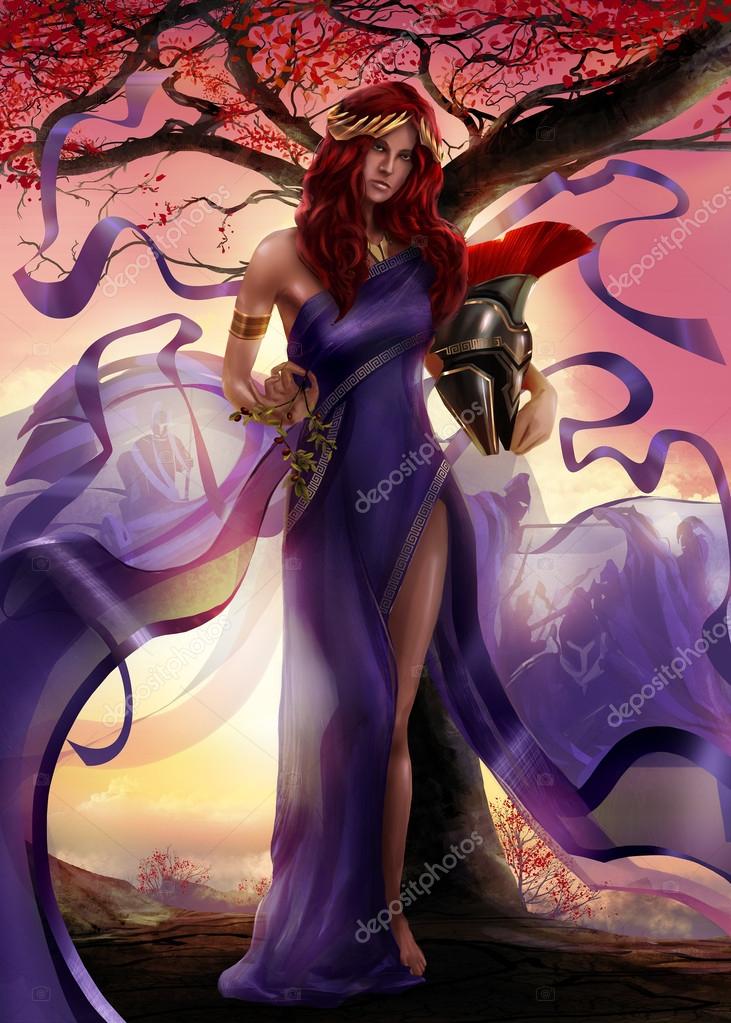

Along with Aphrodite and Hera, Athena was one of the three goddesses whose feud resulted in the beginning of the Trojan War. Athena was the patron goddess of heroic endeavor she was believed to have aided the heroes Perseus, Heracles, Bellerophon, and Jason. She was known as Athena Parthenos "Athena the Virgin," but in one archaic Attic myth, the god Hephaestus tried and failed to rape her, resulting in Gaia giving birth to Erichthonius, an important Athenian founding hero. In the founding myth of Athens, Athena bested Poseidon in a competition over patronage of the city by creating the first olive tree. In others, such as Hesiod's Theogony, Zeus swallows his consort Metis, who was pregnant with Athena in this version, Athena is first born within Zeus and then escapes from his body through his forehead. In some versions of the story, Athena has no mother and is born from Zeus' forehead by parthenogenesis.

In Greek mythology, Athena was believed to have been born from the forehead of her father Zeus. Her main festival in Athens was the Panathenaia, which was celebrated during the month of Hekatombaion in midsummer and was the most important festival on the Athenian calendar. She was also a warrior goddess, and was believed to lead soldiers into battle as Athena Promachos. As the patron of craft and weaving, Athena was known as Ergane. The Parthenon on the Athenian Acropolis is dedicated to her, along with numerous other temples and monuments. She was known as Polias and Poliouchos (both derived from polis, meaning "city-state"), and her temples were usually located atop the fortified acropolis in the central part of the city. In art, she is generally depicted wearing a helmet and holding a spear.įrom her origin as an Aegean palace goddess, Athena was closely associated with the city.

Her major symbols include owls, olive trees, snakes, and the Gorgoneion.

The Parthenon on the Acropolis of Athens is dedicated to her. Athena was regarded as the patron and protectress of various cities across Greece, particularly the city of Athens, from which she most likely received her name. Without proper rendering support, you may see question marks, boxes, or other symbols.Īthena or Athene, often given the epithet Pallas, is an ancient Greek goddess associated with wisdom, handicraft, and warfare who was later syncretized with the Roman goddess Minerva. This article contains special characters. No natural children, but Erichthonius of Athens was her adoptive son Owls, olive trees, snakes, Aegis, armour, helmets, spears, GorgoneionĪeacus, Angelos, Aphrodite, Apollo, Ares, Artemis, Dionysus, Eileithyia, Enyo, Eris, Ersa, Hebe, Helen of Troy, Hephaestus, Heracles, Hermes, Minos, Pandia, Persephone, Perseus, Rhadamanthus, the Graces, the Horae, the Litae, the Muses, the Moirai Roman copy from the 1st century BC/AD after a Greek original of the 4th century BC, attributed to Cephisodotos or Euphranor. It was Athena all along, hopping through religions, appearing with and without her armor as it suited her, and using her cunning to give people a taste of a mighty goddess.Mattei Athena at Louvre. Sophia is even mentioned in Doreen Virtue’s Charge of the Goddess, and several witchcraft books mention her as well. This was technically a new goddess, but I feel certain it was Athena, adapting who she was in order to continue working with humanity.Īnd then, the new age community and some pagan traditions picked up that belief about goddess Sophia. They started calling upon her in rituals and working with her to their great success. The Theosophical Society took the Christian information and believed there was a goddess named Sophia, the goddess of wisdom, even though there was not a goddess with that name in ancient Greece. However, they considered this aspect to be a masculine spirit due to the armor and the reason. This aspect is depicted as an avenging angel, which brings her armor back into play.


 0 kommentar(er)
0 kommentar(er)
